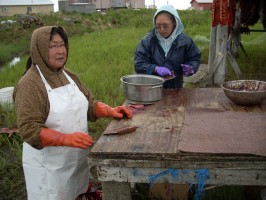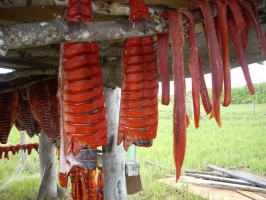Peering into the culture of subsistence and sharing
by Tracy Kalytiak |
Thirty miles west of the Kuskokwim metropolis of Bethel lies Nunapitchuk, a place carved in half by the Johnson River and nestled near land so awash with lakes and swamps you need a boat to reach the village's airport or gas station during the summer.

Two women share the work of cleaning salmon in Nunapitchuk, a community UAA scientists visited in their study of subsistence and sharing. (Photo by Juliana Wassillie)
Juliana Wassillie grew up in this village of 500, experiencing the yearly cycle of subsistence life-eating salmon pulled from the intersection of the Kuskokwim and Johnson rivers, searching for bird eggs, and enjoying berries and greens gathered from the rich tundra.
"We the Yup'ik Eskimos try to survive off the land and depend on our own to feed ourselves with whatever there is in the wild," Juliana wrote. "It is immensely important for me to keep my tradition going and help make it stay that way for years to come."
Going out in the field
But what happens in a subsistence culture when salmon become scarce?
Juliana described her village as part of a UAA multidisciplinary project that's continuing today. The project is examining risk, sharing and the economics and culture of subsistence in salmon-dependent areas of Alaska's Kuskokwim region and the Russian Far East region of Kamchatka.
"Our main objective was, how risk affects cooperation, how sharing is used when you introduce risk into the environment," said Dr. E. Lance Howe of UAA's Department of Economics, who devised and collaborated on the project with Dr. James Murphy, Dr. Colin West, Dr. Andrew Gerkey and Dr. Olga Bogach in Alaska and Dr. Viktoria Petrasheva and Tatiana Degai in Russia. Cristina Gaina, a UAA economics student, and Mikhail Kolodiy, a UAA M.B.A. student, also participated in field experiments done in 2011 and 2013, respectively.
Western Alaska and Kamchatka share similar cultures and ecosystems, but differ in terms of governance, development and resource management.
"The fisheries of these two regions are linked and have recently experienced a major shock," the project's summary explained. "During the last 10 years, runs have declined precipitously with subsequent impacts on resource use. In Alaska, the governor declared the study region an economic disaster area for several years."
Scientists don't fully understand why the decline occurred, but have launched numerous research initiatives in western Alaska concentrating on salmon and the countless biological factors affecting their lives.

Salmon strips dry on a rack in Nunapitchuk, one of the communities UAA scientists visited in their study of subsistence and sharing. (Photo by Juliana Wassillie)
"We want to explore the human-environmental dynamics behind these events, which have received notably less attention," Howe's project summary stated.
The scientists visited Yup'ik, Cup'ik and Koryak communities on both sides of the Bering Sea-learning about the people in those areas, talking to members of the traditional councils and documenting information about local institutions governing the harvest and sharing of salmon and other subsistence resources.
Then, they designed economic experiments to test the effects of risk on the harvest and sharing of resources.
Nunapitchuk and Chevak, Lower Kalskag, Upper Kalskag, Tuluksak and Tuntutuliak participated as community partners in Alaska; the Association of Indigenous Peoples of the North and the Pacific Institute of Geography, Kamchatka, are Russian entities that took part in the research.
UAA undergraduate and graduate students who had lived in the participating communities contributed by writing essays and taking photos.
"They helped us learn about local culture and customs, and gave us an additional glimpse into rural life and subsistence practices," Howe said.
Rich source of research
The National Science Foundation first funded the project back in 2007.
Howe has long been intrigued by how people living in places with low and variable incomes, without access to insurance, can work with others to find stable ways to feed and otherwise support themselves.
Poor households are particularly vulnerable when an "idiosyncratic shock" occurs-the person who catches salmon for his family falls ill or injures his back-or when there's an "aggregate shock"-a region-wide drought, or salmon simply don't return in the numbers people had anticipated-that affects the lives of everyone in the region who depends on salmon.
The scientists' research focuses on how risk influences the design and resilience of local institutions governing salmon and other "common-pool" resources.
"How are households able to smooth consumption the way they do?" Howe said. "The fishery in the region has really been fluctuating. That was one of the motivations of the project in Alaska. Where we were doing this fieldwork, people work together when it comes to fishing, hunting certain animals. When the resource becomes less predictable, how does this affect cooperation and sharing? Can sharing mitigate the effects of risk?"
Howe says answers to those questions could provide critical insights.
"That potentially can be a policy implication," he said. "If sharing helps people cope with risk, policy that doesn't undermine that or makes it stronger is good. That can have implications on conservation, health of the resource and the health of communities."
Wrapping it up
Howe said funding finished last year, but he and the other scientists are still analyzing data they gathered and posting what they've written to their website, www.arcticresilience.org.
"Right now we're still sitting on a lot of data, still writing up data from experiments we've run," Howe said. "Several papers are under development and we're planning on more lab experiments to complement what we've done at this point."
The scientists, in September, returned to several villages to discuss the results of the research and decision-making exercises and make available posters and handouts presenting information about local cultural norms and subsistence practices.
Juliana Wasillie, in her report for the study, said subsistence for her grandchildren will likely be different from today.
One elder in the village told Juliana generations always change-hunters used to oar and use sled dogs to search for food, and now use fuel-dependent motorboats and snowmachines.
"My dad used to tell me and my brother to depend more on subsistence activities for our source of food rather than store-bought food, because one day planes and barges could quit coming to the village bringing groceries if gas was scarce or such [an] epidemic," she wrote. "Anything as possible as that could happen and lead to starvation. He said it would be better to prepare ourselves and continue on our tradition doing subsistence activities."
This story written by Tracy Kalytiak, UAA Office of University Advancement.
 "Peering into the culture of subsistence and sharing" is licensed under a Creative Commons Attribution-NonCommercial 4.0 International License.
"Peering into the culture of subsistence and sharing" is licensed under a Creative Commons Attribution-NonCommercial 4.0 International License.














